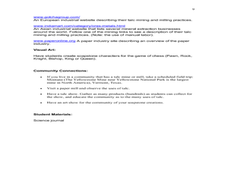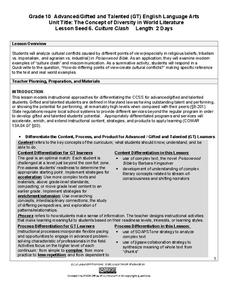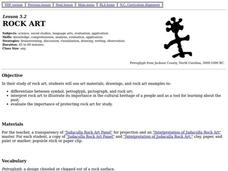Edmond Public Schools
SOAPSTone
Break an article down with a SOAPSTone chart. Class members determine the speaker, occasion, audience, purpose, subject, and tone. The chart includes a question for each of these elements, provides some clarifying text for each, and...
Monarch High School
TP-CASTT Practice
Acronyms can help learners remember facts and analyze poetry. This resource includes graphic organizers for TP-CASTT, SOAPS, SOAPSTone, and DIDLS. Class members can try out one or all of these strategies to assist with that difficult job...
Curated OER
O how I faint when I of you do write:" Analyzing Shakespearean Sonnets Using "SOAPSTone" and Performance
Students encounter how to use SOAPSTone--a strategy that helps students break down a text to comprehend its intended point of view and audience--in order to analyze Shakespeare's sonnets. They then physicalize their knowledge through a...
Curated OER
Bubble, Bubble, Soil and Fun!
Fifth graders experiment to find the physical properties and commercial uses of the mineral talc. They create a soapstone sculpture and a rubric for the creation.
Curated OER
"Soapstone" Relief Sculpture
Students discuss what a relief sculpture is and the history of relief sculptures. Following the brief discussion and a demonstration, students have the opportunity to practice the relief carving technique.
Maryland Department of Education
The Concept of Diversity in World Literature Lesson 8: Nonfiction Close Reading
As part of their study of Things Fall Apart, class members conduct a close reading of a section of Chinua Achebe's essay, "An Image of Africa: Racism in Conrad's Heart of Darkness." Jigsaw groups then compare the voice in the essay...
Ford's Theatre
How Perspective Shapes Understanding of History
The Boston Massacre may be an iconic event in American history, but perhaps the British soldiers had another point of view. Using primary sources, including reports from Boston newspapers and secondary sources from the British...
American Museum of Natural History
Mint Your Own Coin
Provide young archaeologists with an opportunity to craft their own artifacts. The step-by-step directions in an engaging resource show them how to mint their own coin, complete with image, date, and motto.
Maryland Department of Education
The Concept of Diversity in World Literature Lesson 6: Culture Clash
To prepare for a Quickwrite on the question, "How do different points of view create cultural conflicts?" class groups draw examples of religious, cultural, and political conflicts from Things Fall Apart and The Poisonwood Bible to use...
Reading Through History
Ain't I a Woman?
Sojourner Truth’s “Ain’t I a Woman?” speech has reverberated through American history, giving voice to women of color who had not previously been heard. Learners analyze the tone, audience, purpose, occasion, and speaker of the speech’s...
Idaho State Department of Education
Lessons for Social Studies Educators
Point of view, purpose, and tone: three concepts readers of primary and secondary source materials must take into account when examining documents. Class members view a PowerPoint presentation and use the SOAPS strategy to identify an...
Curated OER
Fifth Grade Science
In this science worksheet, 5th graders answer multiple choice questions about the ocean, animals, rocks, and more. Students complete 25 questions.
Curated OER
Aegean Art Cycladic Art 3200-1050 BC, Minoan Art 3000-1100 BC, and Mycenaean Art 1600-1100 BC
So exciting, art from the ancient mediterranean! Get ready to divulge interesting facts about the art and culture of the Minoans, Mycenaeans, Aegeans, and Cycladians. Each slide provides a map, images of art, and the cultural...
Curated OER
5th Grade Science
In this science worksheet, 5th graders complete multiple choice questions about flight, astronomers, measurement, temperature, and more. Students complete 25 questions.
Curated OER
U.S. Involvement in WWI – The Zimmerman Note
Students investigate the significance of the Zimmerman Note. In this World War I lesson, students use the provided analysis sheet to analyze the contents of the Zimmerman note and discuss how the note led to U.S. involvement in World War I.
Curated OER
Pop Around the World
Students study the origin of popcorn. They locate countries where it is grown on a world map. They color the world map and glue kernels of popcorn onto the countries from which popcorn originated. They write the names of common items...
Curated OER
Rocks, Minerals, and Erosion
Fourth graders describe the difference between minerals (composed of the same substance throughout) and rocks (composed of two or more minerals). They recognize that there are three classes of rocks: igneous, sedimentary, and metamorphic
Curated OER
Rock Art
Fourth graders examine and interpret rock art to illustrate its importance in the cultural heritage of a people and as a tool for learning about the past. They create their own rock art that is a symbol of their culture.
Curated OER
Welding Terms
For this literacy worksheet, learners find the vocabulary terms that describe welding and the answers are found by clicking the button at the bottom of the page.
Curated OER
Analyzing Speaker, Language, and Tone in the Writings of Benjamin Franklin
Students analyze writings by Benjamin Franklin. In this Benjamin Franklin lesson, students discover the pseudonyms under which Franklin used to write. Students compare and contrast 2 selections by Franklin.
Curated OER
Not Just For A Baby's Bottom
Eighth graders investigate the presence of talc in the geologic record. The different characteristics of talc is covered. The lesson includes background information for the teacher.






















